I decided to answer this pvt message here so all can participate.
First, your camcoder DV tapes have correct black if recorded from the camera section of the camcorder. DV camcorders will record black at digital level 16. When this is transferred to the PC over IEEE-1394, black remains at digital level 16 and gets authored to the DVD at digital level 16 and all is well. When an NTSC DVD player plays the DVD, it is supposed to scale digital level 16 to analog level 7.5 IRE for correct NTSC black.Originally Posted by jrank001
If you play the tape from the camcorder to analog outputs, black will be incorrect at 0.0 IRE. If you capture camcorder playback to an analog NTSC capture device, the bottom 7.5% of the black range will be chopped off, or recorded below black level 16. The result will be "crushed blacks" with loss of detail in black and a dark picture. So you should always use IEEE-1394 to transfer your DV video from the camcorder to the PC.
As for analog "pass through" capture through the camcorder analog inputs, NTSC black level (7.5 IRE) will be incorrectly captured to digital level 32. The result is a grayish black like this example (left side). This slide shows the Vegas levels filter correcting the black level (right side). Other levels filters can also be used to lower Y (luminance) values by 7.5% lowering black from digital level 32 to 16. Vegas has the waveform monitor to help you see what is happening to luminance levels.
Your path:
VCR ---TBC---DETAILER---BVP4---SONY DCR-PC110 (pass though device) PC
allows for adjusting black level from 7.5 IRE to 0.0 IRE before camcorder capture using the BVP4. Adjusting black at the camcorder input to 0 IRE results in black capture to level 16. The only problem is you can't see what you are doing unless you do test captures to view the results of your adjustments. The Vegas waveform monitor is good for this but I wish it operated real time on the capture input so analog adjustments could be directly monitored. Sadly it doesn't so you must capture before the monitors can be used.
The left is uncorrected black level, the right is corrected. So these adjustments can be made before capture in the analog domain or after capture with digital levels filters. The problem with the analog method is seeing what you are doing unless you use trial and error captures. Pros will use analog waveform monitors to adjust black and white levels and use calibrrated TV monitors.
The Canopus ADVC 100 or 110 can also be used for capture in place of the DV camcorder. The ADVC includes a 0.0/7.5 IRE black switch. In the 7.5 IRE mode, NTSC black is captured correctly to digital level 16. No further adjustments are required. If the switch is set to 0 IRE, the ADVC will do the same as a camcorder by mapping analog 7.5 IRE to digital 32 resulting in washed out blacks.
See this JVC tutorial:
http://pro.jvc.com/pro/attributes/prodv/clips/blacksetup/JVC_DEMO.swf
Ask again if any of this is unclear.
Try StreamFab Downloader and download from Netflix, Amazon, Youtube! Or Try DVDFab and copy Blu-rays! or rip iTunes movies!
+ Reply to Thread
Results 1 to 30 of 85
Thread
-
-
I think you should emphasize that the "incorrectness" applies to NTSC as implemented in North America. For NTSC implementations in RoW, the (predominantly Japanese/Far East) equipment is doing the "right thing".
John Miller -
Well NTSC started here and 7.5 IRE black was done for a reason back in the 40's-50's.
Japan, Korea and Taiwan adopted NTSC in the 60's. By then TV sets and transmitters were more stable so they could start color with 0-100 IRE. The same was done in the 60's for PAL. In PAL lands they decided to obsolete all monochrome sets and start fresh with 625/50 PAL on separate channels.
In the US/Canada/Americas it was decided to maintain compatibility with the large installed base of monochrome and early color TV sets in the field. A change to 0-100 IRE would have required adjustment to all TV sets in the field. I wish they would have bit the bullet then but they didn't.
The issue is finally corrected with the conversion to digital (everything is 16-235 digital) but the legacy analog issues will remain for decades. -
So to save a lot of hassle for me it would probably be best to purchase an ADVC-110, (What is the difference from the 100 to the 110?) use in place of my Sony DCR-PC110, set switch to 7.5 IRE black, and capture to PC and I’m good to go. Is that correct?
Thanks“When Memories Exceed Dreams Life Is Over” -
That will do it if you can spare the $230. Fixes that one problem.Originally Posted by jrank001
-
I have been curious about this for some time... Hope for some help...
I capture two ways from analog:
1) from old vhs-c thru (composite cable + stereo L/R audio) to Canapus ADVc 100...IRE set at 0--to computer thru firewire...video seems ok, is this correct?
2) I have a Sony digital trv-320 which I occasionally put an old analog 8mm tape in and output thru firewire to PC...after reading stuff above I seem to think blacks may be a bit grey...or could be my imagination? Is it doing it right automatically or do I need to set something?
I have been editing/finishing my videos with Ulead VS 7,8,9, and 10. they have various levels of filtering capability which I prefer not to mess with unless given some idiotproof advice...
Thanks in advance. -
edDV. You said that it fixes that one problem. Could you elaborate? Is there something else? Is there a difference between the 100 and 110 units? Which would you get?
Thanks“When Memories Exceed Dreams Life Is Over” -
I think what he is saying is this ...Originally Posted by jrank001
Buying the Canopus ADVC-110 to fix the IRE BLACK LEVEL issue is going to fix that ONE problem AT a rather high price tag.
Since you already have DV IN via the camcorder (analog-to-digital passthrough) he is suggesting that it can be fixed afterwards by adjusting the VIDEO LEVELS correctly.
So why spend all that money for a Canopus ADVC-110 when it can be fixed easily afterwards.
At least this is how I am reading his comment(s).
- John "FulciLives" Coleman
P.S.
It can also be fixed prior to capture with the BVP4."The eyes are the first thing that you have to destroy ... because they have seen too many bad things" - Lucio Fulci
EXPLORE THE FILMS OF LUCIO FULCI - THE MAESTRO OF GORE
-
I just want to make sure I understand this correctly. Please bear with me and confirm or deny what I am saying. Thank you!Originally Posted by edDV
If I understand you correctly and I capture a NTSC source (7.5 IRE BLACK) using a device set to 0.0 IRE BLACK (such as the input of a digital camcorder using analog-to-digital pass through) then in order to "fix" the IRE "mis-match" I just have to change the SONY LEVELS in VEGAS as per your image above?
Well I have VEGAS 7.0b Build 151 (even though I admit that I barely know how to use it) and I did that. What I mean is I loaded a source video and brought up the SONY LEVELS and it looked like this at the default:
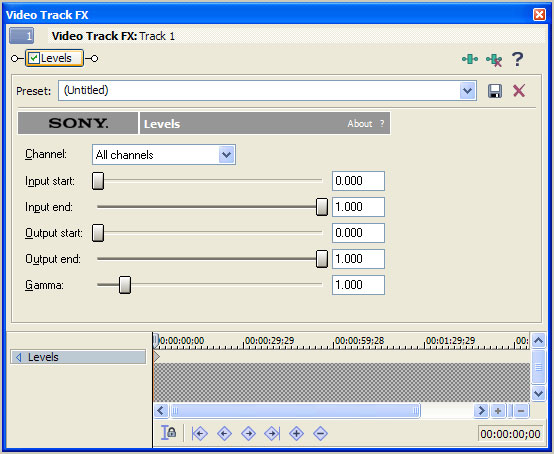
So again if I understand you correctly I just have to change the INPUT START from the above example to the following example:
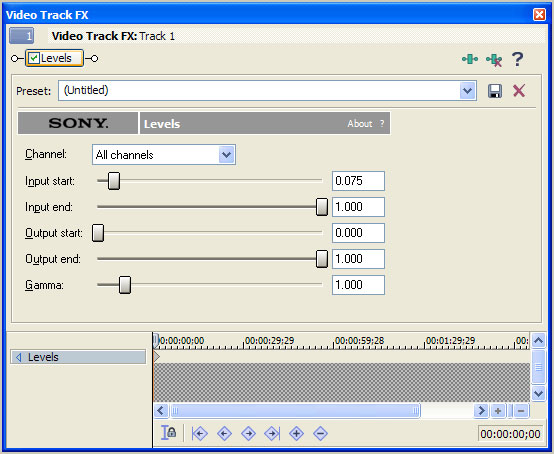
And doing that ... and nothing more ... is all that is needed to fix the IRE "mis-match"?
That almost seems "too easy" if you know what I mean
- John "FulciLives" Coleman"The eyes are the first thing that you have to destroy ... because they have seen too many bad things" - Lucio Fulci
EXPLORE THE FILMS OF LUCIO FULCI - THE MAESTRO OF GORE
-
I don't have any VHS-C camcorder samples here to test. All other VHS records what it is given as an input. Normally this would be NTSC with 7.5 IRE setup. The internal VHS tuner will produce 7.5 IRE setup. In the Americas, best to assume all VHS has 7.5 IRE setup (ADVC switch in 7.5 IRE position).Originally Posted by bhbuckeye
With the switch in the 7.5 IRE position, VHS will look like this after capture.

With the switch set to 0 IRE the black is captured abnormally high like this.
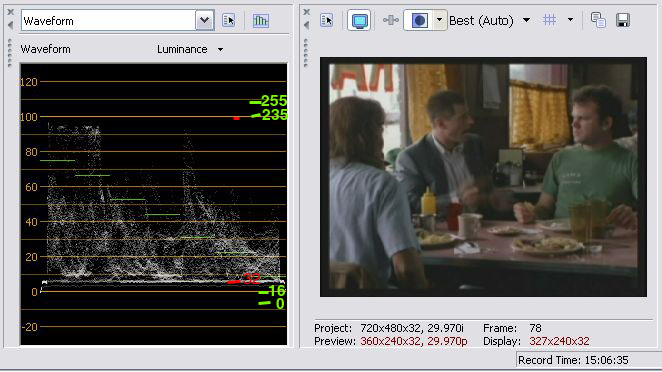
My experience playing 8mm and Hi8 with a Digital8 camcorder has been very good for levels. Black gets assigned to digital level 16. White varies by recording camcorder. Prosumer models control whites better. Consumer 8mm/Hi8 camcorders tend to use all the range up to digital level 255 and often clip at 255.Originally Posted by bhbuckeye
Here are some examples. D8 playback camcorder was a DCR-TRV103.
Sony CCD-V5000 Hi8
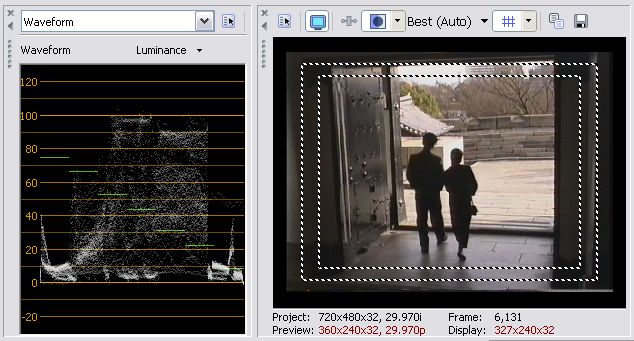
Sony CCD-V5000 Hi8 (Low light)
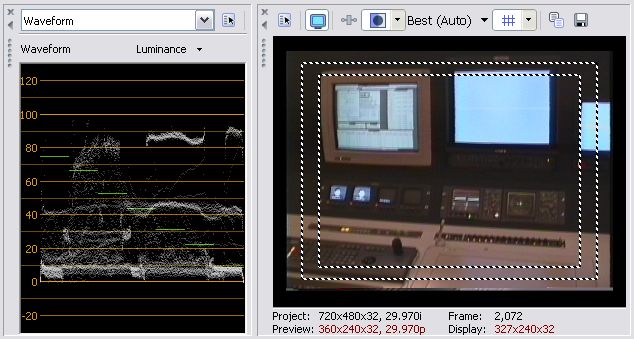
Canon consumer Hi8 (~1991)
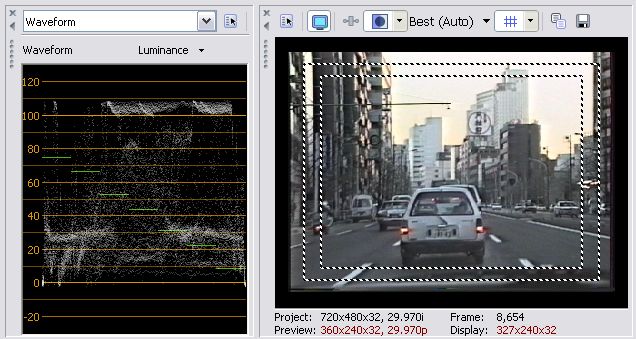
Sony 8mm
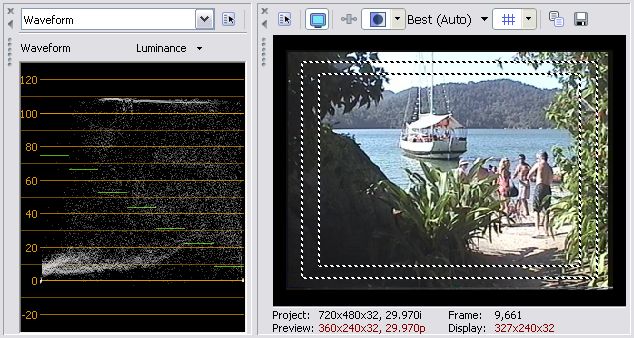
-
That would work without need for correction. But if you use the equipment above, you might want to experiment with the proc amp and paint a marker for -7.5% on brightness.Originally Posted by jrank001
The 100 and 110 are very similar. The new 110 can work off computer power. Power supply is optional. The older 100 had a second set of inputs on the back which I find useful.
http://lib.store.yahoo.net/lib/computervicestore/Canopus.advc-100-ds.pdf
http://www.canopus.com/products/ADVC110/index.php -
It fixes the black level problem. A proc amp can also correct white levels and color shifts. For example, it would be nice to pull down the white sky levels on those consumer camcorders.Originally Posted by jrank001
-
That is it. If you watch the waveform monitor, it causes the black end of the video to stretch down. "Output End" does a similar stretch at the whites. The downside is all frames need to be processed slowing the render a bit.Originally Posted by FulciLives
You will see that the picture is far more sensitive to small level shifts at the black end of the scale.
PS: I described the Vegas levels filter at the bottom of this thread.
https://forum.videohelp.com/viewtopic.php?t=259098&start=90 -
Would there be a levels adjustment tool for AviSynth that works the same? I would imagine so ...Originally Posted by edDV
I'll have to look into it.
- John "FulciLives" Coleman"The eyes are the first thing that you have to destroy ... because they have seen too many bad things" - Lucio Fulci
EXPLORE THE FILMS OF LUCIO FULCI - THE MAESTRO OF GORE
-
FYI, for DV material, you can perform real-time Proc Amp adjustments during capture using our Enosoft DV Processor.
John Miller -
AviSynth has the built in Levels() filter and you can view the effects with Histogram()Originally Posted by FulciLives
I've also read that there are other, more fully featured filters available but I don't know if they would be any better for this specific issue."Shut up Wesley!" -- Captain Jean-Luc Picard
Buy My Books -
Can your DVProcessor adjust the IRE levels after I've captured? How fast can it do that for me?
Also, there isn't a simple filter in Pinnacle Studio that I could use, is there? -
Yes, it can.Originally Posted by anonjon
Speed-wise: I just ran a test on a 16 second clip.
With the program visible, it took 11 seconds to process it on a 1.8GHz Pentium M laptop (single CPU).
With the program minimized, it took 7 seconds.
(Minimizing it means that the preview windows don't need to be updated).
By default, the processing will occur in real-time. You have to set the Disable seeking/navigation option to run as fast as possible.John Miller -
I'm sorry to have to ask you another question, but now that I've got it installed, what exactly do I do? I can load the DV-AVI file alright, but what then? I got into the video Proc Amp, but which one do I adjust? Will adjusting this particular part change everything else? Will that be good? Thanks for responding!
-
Before loading the AVI, goto the main configuration settings and set the "Disable seeking/navigation" - this will prevent the software from running in real-time. Instead, it will run as fast as the computer permits(!)
Enable the Proc Amp
Open the Proc Amp settings and enable the Luma Offset slider. Leave the others disabled.
Adjust the slider to read -48.
Close the Proc Amp settings window if you want to.
Choose either Type-1 or Type-2 AVI for output.
Press the large Run button.
That's it!
Once running, you can minimize the application - that will speed things up somewhat since it doesn't have to draw the input and output video windows etc.
Note: You can save the configuration via the Save... button on the main window. Then, next time you run the program, you can Load... the same settings back (or drag-and-drop the configuration file).John Miller -
The levels filter will work, but I find using levels, as in a graphics editor, can redistribute values throughout the range -16-235, which is not always desirable. I prefer using ColorYUV(off_y=-16), perhaps with a bit of gain added, if needed.FulciLives wrote:
... Would there be a levels adjustment tool for AviSynth that works the same? I would imagine so ...
I'll have to look into it.
- John "FulciLives" Coleman
AviSynth has the built in Levels() filter and you can view the effects with Histogram()
I've also read that there are other, more fully featured filters available but I don't know if they would be any better for this specific issue. -
So what exactly is ColorYUV(off_y=-16) doing?Originally Posted by andie41
- John "FulciLives" Coleman"The eyes are the first thing that you have to destroy ... because they have seen too many bad things" - Lucio Fulci
EXPLORE THE FILMS OF LUCIO FULCI - THE MAESTRO OF GORE
-
I am new to avisynth (after years of resisting), and am certainly not an expert, but ColorYUV(off_y=-16) is simply lowering (offsetting) the "Y" value by 16(of course, can be more or less.) There is a similar function available in Vegas, as well. I usually add "gain_y=16". It may be doing much the same as levels, but it appears to give more control, and I use some of the other options available with ColorYUV(), to adjust the gamma and the "u" and "v", as well. I use the ColorYUV() instead of "Levels" and "Tweak".So what exactly is ColorYUV(off_y=-16) doing?
-
Minus 16 on Y is enough to compensate for NTSC 7.5 IRE setup.
-
edDV, would you also recommend pulling down the whites in the level event in Vegas so they conform to the 16-235 range?Originally Posted by edDV
One other question: capturing video8 with a Digital8 (gvd200), it seems from my captures looking at the Vegas waveform and histogram that the blacks are captured at level 32, at least for outdoor scenes. For dark interior scenes, the blacks seem to be about right as captured ( if i correct them downward, they get crushed ). It looks like I will need to go through and manually correct just the outdoor scenes. Any thoughts on this? -
I seem to get consistent black to 32 when using DV camcorder pass through but the waveform monitor tells what is really going on. Make sure Vegas is in DV project mode and the waveform monitor preference is set to "7.5 IRE" unchecked, "studio RGB (16-235)" checked.Originally Posted by Jiminy
Once black is set, you can tone down the Video8 whites to near 100% if you want similar contrast when you switch between TV, commercial DVD and your camcorder DVD. You may need to tweak gamma as well. -
Jiminy
My Video 8 to Digital 8 "captures" also yield black at level 32. I would not expect your camera to have recorded outdoor/indoor black at different levels. Also, my standalone DVD players add 7.5 IRE to my DVD's, yielding muddy blacks, unless I bring my captured video level down from 32 to 16. -
I checked Vegas to make sure it was in DV mode, 7.5 IRE was unchecked and 16-235 was checked. Everything was set correctly.
I hooked up the GVD200 to my TV through both 1394 and svideo to check if I could see the 16 level difference between the two. Sure enough, the 1394 view was always lighter in the blacks, consistent with blacks at the wrong level. I found that the dark areas in some cases were perhaps a bit under exposed in the svideo view - especially in the dark indoor scenes. So reducing the brightness with the -16 correction simply made those clips look worse than if I didn't do the correction. This explains to some extent why I thought that the darker scenes didn't need the correction - they were a bit under exposed to begin with and could actually benefit from less correction.
When I originally created the DVD with the -16 levels correction, I had run it through VirtualDub to lower the blacks by 16 using the levels filter. I simply set the input level to 16 and the output level to zero. ( I also mapped the bright areas down by setting the output to 237 or so, and input to 255. Loading the resultant avi file into Vegas I see that VirtualDub compressed the blacks so that essentially nothing went below the zero IRE line. In Vegas if I reduce the blacks by 16 using the levels event FX(by setting the input start to .07), it allows values to go below zero IRE. It appears that Vegas leaves more detail in the black area compared to the VirtualDub.
I haven't burned a DVD yet to view it on the TV, but I expect that the Vegas applied correction will look much closer to the original svideo view from the camcorder, than the VirtualDub corrected version. The VirtualDub effect that compressed the blacks into a narrow band on the waveform monitor probably contributed to my sense that the blacks were too dark in some of the darker indoor scenes.
In the end I'll probably reduce the amount of the -16 correction for some of the really dark indoor scenes to get more shadow detail. -
It's possible for video to extend below level 32 (16 after adjustment) when capturing through a DV camcorder. It just means the input signal had black below 7.5 IRE. This often happens with maladjusted cable tv systems.
If your TV is properly adjusted anything under level 16 will be black. If too much is pushed below 16, the result is known as "crushed blacks". -
Thanks edDV.
I have an ADVC 300 and it has this switch as well. My inputs are varios HI-8, Digital 8 and VHS tapes runinng through aVCR I bought int hte US.
I had thought the blacks looked grey and I always thought the IRE setting was something to do with Ireland! (Just kidding).
I have flipped the switch and will see what happens :-)
Similar Threads
-
YCbCr 16-235 to RGB 0-255 and PAL/NTSC differences (7.5 IRE)
By intracube in forum Video ConversionReplies: 11Last Post: 5th Sep 2011, 04:39 -
NTSC Camcorder feed thru capture from PAL
By INFRATOM in forum Camcorders (DV/HDV/AVCHD/HD)Replies: 5Last Post: 29th May 2009, 01:17 -
ntsc tapes pass through pal camcorder into mac for ntsc playing?
By tozier9 in forum Newbie / General discussionsReplies: 5Last Post: 7th Dec 2008, 17:19 -
OK, one more time: IRE levels from AVI capture to DVD authoring
By sanlyn in forum Video ConversionReplies: 3Last Post: 13th Jun 2008, 14:54 -
What is the Best MiniDV Camcorder with analog/digital pass-through
By DigitalGuard in forum Camcorders (DV/HDV/AVCHD/HD)Replies: 12Last Post: 20th Jun 2007, 14:18






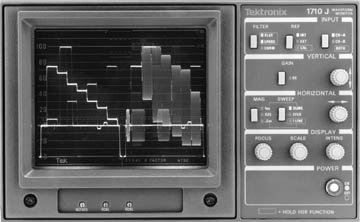
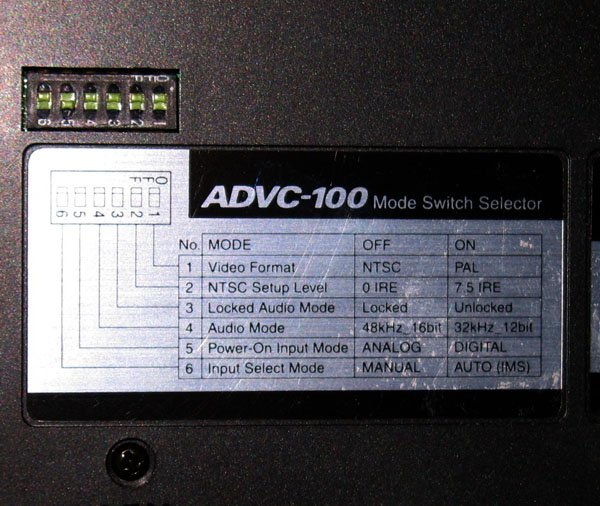
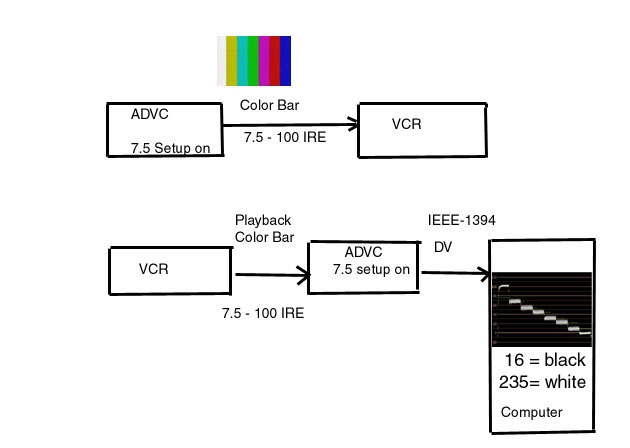
 Quote
Quote